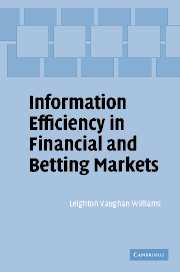Book contents
- Frontmatter
- Contents
- List of figures
- List of tables
- List of contributors
- Introduction
- Part I The concept of information efficiency
- 1 Information efficiency in financial markets
- 2 Weak form information efficiency in betting markets
- 3 Semi-strong and strong form information efficiency in betting markets
- Part II Selected readings
- Index
- References
3 - Semi-strong and strong form information efficiency in betting markets
Published online by Cambridge University Press: 09 July 2009
- Frontmatter
- Contents
- List of figures
- List of tables
- List of contributors
- Introduction
- Part I The concept of information efficiency
- 1 Information efficiency in financial markets
- 2 Weak form information efficiency in betting markets
- 3 Semi-strong and strong form information efficiency in betting markets
- Part II Selected readings
- Index
- References
Summary
Introduction
So far, our analysis has concentrated on weak form information efficiency in betting markets. In this chapter the focus turns to semi-strong and strong form efficiency. Semi-strong form information efficiency is the notion that current prices incorporate all publicly available information. In consequence, in a financial market which is semi-strong efficient it should not be possible to earn above-average or abnormal returns on the basis of information which is publicly available. In a market which is strong form efficient it should not be possible to do so even if given all information, including private information. Indeed, any such strategy should on average yield the same return, unless there are differential costs or risks associated with these strategies.
The existence of semi-strong efficiency in betting markets would imply, therefore, that the expected returns to any bet, or type of bet, placed about identical outcomes on the basis of publicly available information, should be identical (subject to identical costs and risks). The same applies with respect to strong efficiency when assessed in respect of all information. Otherwise bettors could use this information to increase their expected returns. In a semi-strong efficient market, for example, the expected return to a bet placed on a horse on the parimutuel (or ‘Tote’) should be identical to that available with bookmakers, should both options be available. Similarly, it should not be possible to identify patterns in the returns which can be used to yield above-average or abnormal returns.
- Type
- Chapter
- Information
- Information Efficiency in Financial and Betting Markets , pp. 123 - 156Publisher: Cambridge University PressPrint publication year: 2005



